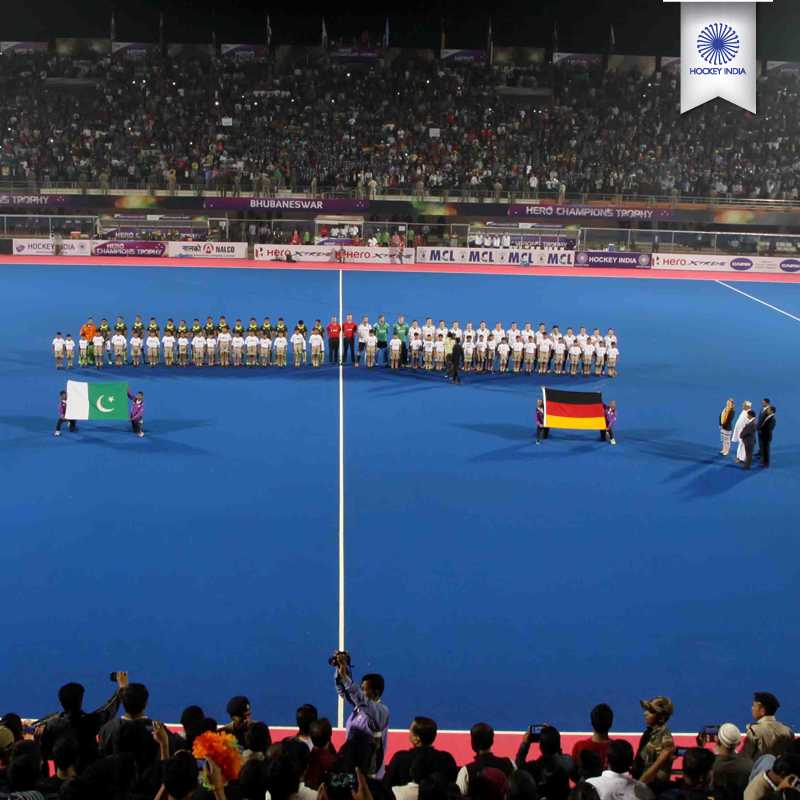Sport is for spectators, and on this count the Champions Trophy organizers have been amply awarded. The stadium has been invariably full for the evening games, and well-attended for the day games. On Friday we saw a serpentine queue for tickets, with some impact on the traffic, which still remained meticulously controlled. The Odia and English newspapers are full of front page stories about the Champions Trophy.
The credit for the successful promotion of this tournament goes to Hockey India and the Government of Odisha. Hockey India CEO Elena Norman has been leading from the front, tirelessly taking calls, supervising volunteers, always smiling, with her dedicated team. Saswat Mishra, the energetic co-chair from the Odisha government, has camped at the site with his compatriots from the government, determined to set the standards to win Bhubaneswar the bragging rights in Champions Trophy organization.
But there is a clear strategy behind this leg work. The Odisha government’s pioneering vision of public private partnerships shows what advocacy can do to sport. When sport has a nod from both government and industry, there is a positive impact. In this case the government of Odisha read the transformative potential of hockey correctly. Firstly, you have to perform at a high level to get the attention. Odisha has produced good hockey players for national service, with a growing fan following. But you need to create the infrastructure as well. The government has harnessed the Kalinga Stadium complex to transform the city of Bhubaneswar.
The organizers have leveraged Odisha’s rich hockey history to step up the tournament’s tempo. Some of this history needs recounting. Saswat Mishra told me that in the 1970s, Dhenkanal, Ganjam and Sundergarh were the hockey-playing regions of Odisha. Why did the plainsmen fall behind while Sundargarh prospered? The answer is that an astro turf was laid at the Panposh Hockey Academy, and the coastal region had no such infrastructure. With success in world hockey aligned to artificial surfaces, Panposh produced the India players, while hockey in Ganjam and Dhenkanal declined.
Now, with the creation of the Kalinga Stadium infrastructure, there is an opportunity to create a parallel hockey nursery. Odisha’s plainsmen are steeped in the arts, but hockey is an art too. Will the plainsmen bite the convenient presence of the new infrastructure, and close the tribal versus plainsman debate about hockey prowess in Odisha? The great players from Punjab also came from the plains. If Samsarpur’s Punjabi legs could do all the running to make so many hockey Olympians, why can’t the legs from the deltaic plains of Odisha do the same? After all, the human body is not genetically engineered to excel in certain tasks and falter in others.
The Odisha government already runs the Panposh and Sundargarh hockey academies for junior boys and girls. After the Kalinga Stadium was built the senior boys and girls shifted to Bhubaneswar, and the plan is to open a hostel in Bhubaneswar for the junior boys and girls, for the plainsmen to play grass root hockey. The construction of the stadium was funded by the Government of India under the Urban Sports Infrastructure Scheme, with help from the State government, another example of good cooperation between the central and state governments.
This tournament could be a sporting turnaround. The infrastructure will become the city’s icons, but it is not enough to sit on laurels and turn a living entity into a museum. Using the facilities for both training and competition will consolidate Bhubaneswar’s rank as a hockey hub. The challenge will be to draw the people of the region to the stadium, and let the tribesmen and plainsmen mingle. Out of this will emerge a core group of players that will feed the state’s hockey. Sporting events are rallying symbols for change and governments can be forces for the good.
This tournament could be a sporting turnaround. The infrastructure will become the city’s icons, but it is not enough to sit on laurels and turn a living entity into a museum. Using the facilities for both training and competition will consolidate Bhubaneswar’s rank as a hockey hub. The challenge will be to draw the people of the region to the stadium, and let the tribesmen and plainsmen mingle. Out of this will emerge a core group of players that will feed the state’s hockey. Sporting events are rallying symbols for change and governments can be forces for the good.
The Odisha government’s vision is for reaping the dividends of all the hard work. After Bhubaneswar’s success in hosting the Kalinga Lancers’ heavily-attended home games in the Hockey India League, the government felt the time had come to bid for the Champions Trophy. Key to this was winning the confidence of the private sector and winning sponsorships. The results are there to see.
The reality is that hockey finds sustenance from the hinterland. As Chief Secretary Gokul Chandra Pati told me, the government is committed to supporting hockey at the rural level. This is sound logic, because it is the hinterland that has produced Odisha’s hockey players. But while western Odisha has led the State’s hockey, the time has come for others to contribute as well. If the mountain people of western Odisha can live and train in Bhubaneswar why can’t people from the surrounding districts gravitate towards this wonderful hockey city? Sporting events are known to have a transformative effect on urban communities and we can hope that the Champions Trophy will have just this sort of impact.
Writer: Jitendra Nath Misra, an Indian Foreign Service officer, is currently India’s ambassador to Portugal. (The political and business daily)

